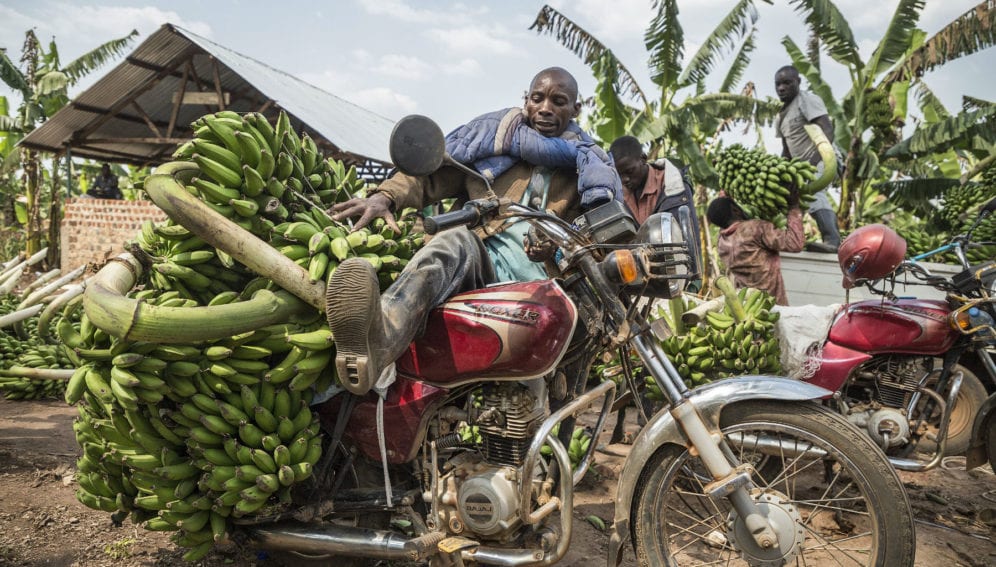By: Baraka Rateng’
Send to a friend
The details you provide on this page will not be used to send unsolicited email, and will not be sold to a 3rd party. See privacy policy.
The African Development Bank aims to boost agricultural productivity by helping scale up proven technologies. Its flagship programme, Technologies for African Agricultural Transformation (TAAT), is a priority of that agenda, also called the Feed Africa Strategy.
In an exclusive interview, Jennifer Blanke, the Bank’s vice-president talked with SciDev.Net about ways to transform African agriculture.
What are some of the bottlenecks to economic growth through agriculture in Africa?
Major bottlenecks include low productivity, challenges to finding sustainable ways to scale up successful food production technologies to farmers, and insufficient access to markets.
For decades, many attempts and commitments to transform African agriculture have not come to full fruition partly due to a lack of funding by national governments, and the high cost of getting inputs to farmers and [of] produce to the market.
Agricultural finance, in all its forms, is in short supply in Africa. Smallholder producers, small and medium size agricultural enterprises and early-stage firms suffer the greatest barriers to having access to funding for agriculture.
“Agricultural finance, in all its forms, is in short supply in Africa,”
Jennifer Blanke
How can the financial sector accelerate Africa's agricultural growth?
Neither commercial banks nor the emerging microfinance industry are willing or able to sufficiently meet the financial needs along agricultural value chains. This leaves many commercial smallholders and agricultural small and medium enterprises underserved.
On average, less than three per cent of total commercial bank lending goes into Africa’s agricultural sector. Agriculture suffers from a perception of being high risk and with modest return.
The African Development Bank takes a multipronged approach to solve this problem. We are working to establish a risk-sharing model that provides incentives to financial institutions to increase lending to the sector.
We also aim to eliminate dependency on governments for funding agriculture.
The Bank’s Feed Africa Strategy fosters coordination across key actors in the agriculture sector — for instance, though our partnership efforts in TAAT and the Leadership4Agriculture Forum that brings together agriculture policymakers, ministers of finance and agribusiness leaders to interact and assess policy reforms.
In Africa, the youth seems disinterested in agriculture. How can this be reversed?
More than 60 per cent of Africans are below 35 [years old], and more than half live in rural areas. Thus, it is critical for the agricultural sector to be seen as an exciting employment and business opportunity for young people. Young people can be the engine of Africa’s economic transformation through agribusiness if their talents and energy are harnessed.
One of the African Development Bank’s initiatives to help youth embrace this mindset is called Empowering Novel Agri-Business-Led Employment Programme or “Enable Youth” in short. [It] provides training, agribusiness development, exposure to new agricultural technologies and access to finance.
We also establish connections between up-and-coming entrepreneurs and businesspeople in the agricultural sector, with established companies, investors, and farmers.
In areas where novel scientific innovations do exist, how can they be made accessible to smallholders, most of whom may be illiterate?
The mere existence of novel scientific innovations will do little to improve the welfare of vulnerable smallholders if these innovations are not made available to wider audiences.
Furthermore, scientific innovations must be deployed in a manner inclusive of farmers lacking strong reading or writing skills. This requires careful handling and planning.
Engaging with a small number of literate farmers who in turn can share that knowledge in local languages to an illiterate majority is key to inclusive agricultural transformation success.
“An enabling policy environment is needed to facilitate massive uptake of agricultural technologies for increased productivity to make agriculture a viable business,”
Jennifer Blanke
Women make up a larger proportion of smallholders in Africa, but some studies indicate that many innovations are not user friendly to them. Your thoughts on this?
Gender analysis has historically not been seen as integral to the core business of agricultural research. So for the most part, researchers have not yet developed a robust understanding of how women and men use technologies differently in agricultural value chains.
An agricultural value chain starts well before the farm; it begins at the research stage, with scientists making decisions that have critical bearings on what happens across the entire chain. It is crucial that agricultural research and subsequent innovations recognise and respond to the different priorities and needs of both men and women.
By focusing on innovations that address the constraints and priorities of African farmers at the margins, especially women, gender-responsive agricultural research offers the potential to maximise the efficiency and efficacy of African agricultural R&D.
What advice for transforming African agriculture do you have for policymakers?
An enabling policy environment is needed to facilitate massive uptake of agricultural technologies for increased productivity, to make agriculture a viable business.
African policymakers should liberalise national seed systems and harmonise registration of inputs such as seeds and fertilisers. Registration across regions [will] enhance transfer of technologies without borders.
In addition, long-term, low interest loans for buying agricultural machinery, inputs and land development should be provided to create a competitive agricultural sector. We need to remove inappropriate trade policies, such as export bans, to provide farmers a fair price for their produce.
Other policies, such as secure land titles, are also required to facilitate investment in land development. It is critical to embrace agriculture as a business.
Q&As are edited for length and clarity.
This piece was produced by SciDev.Net’s Sub-Saharan Africa English desk.














